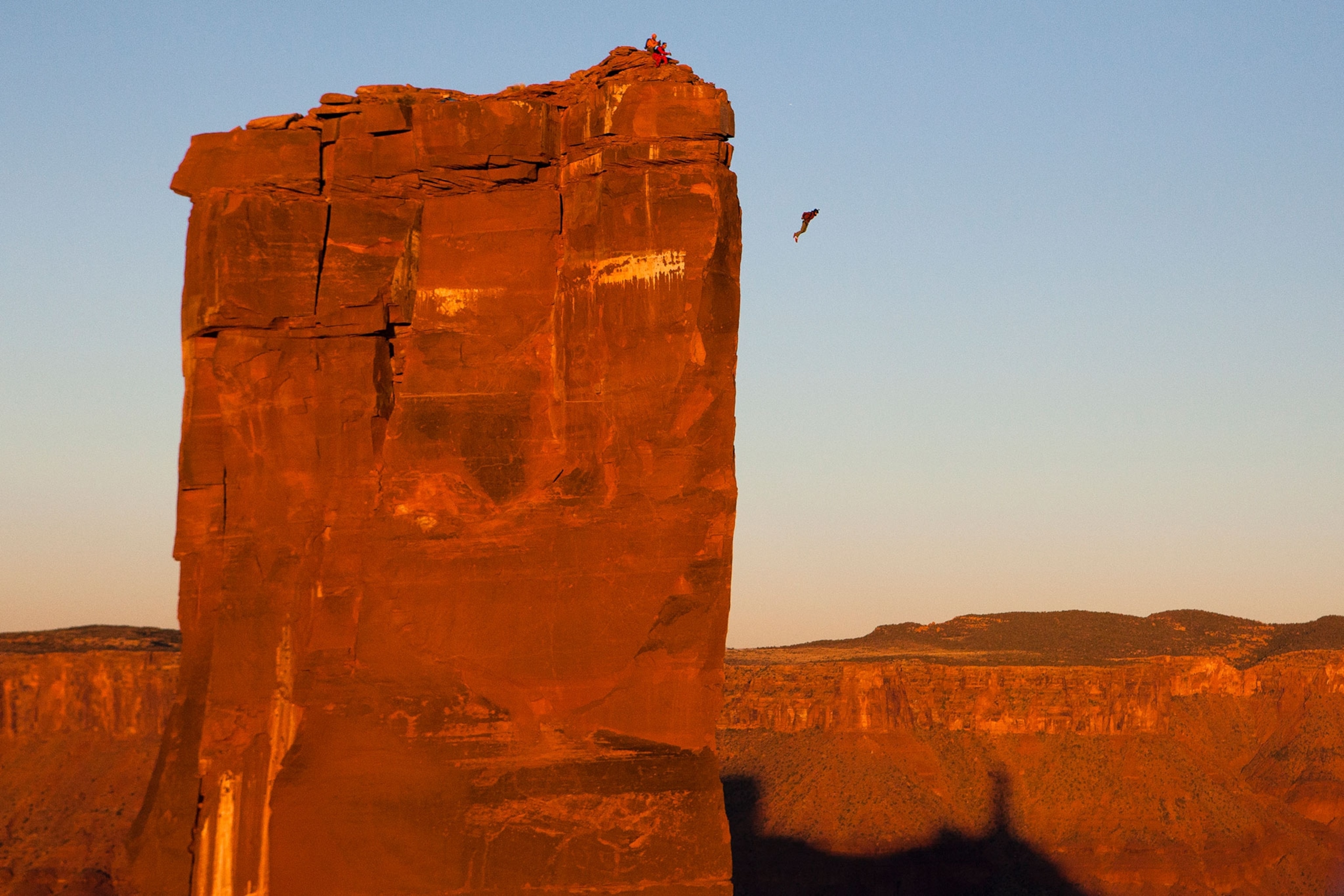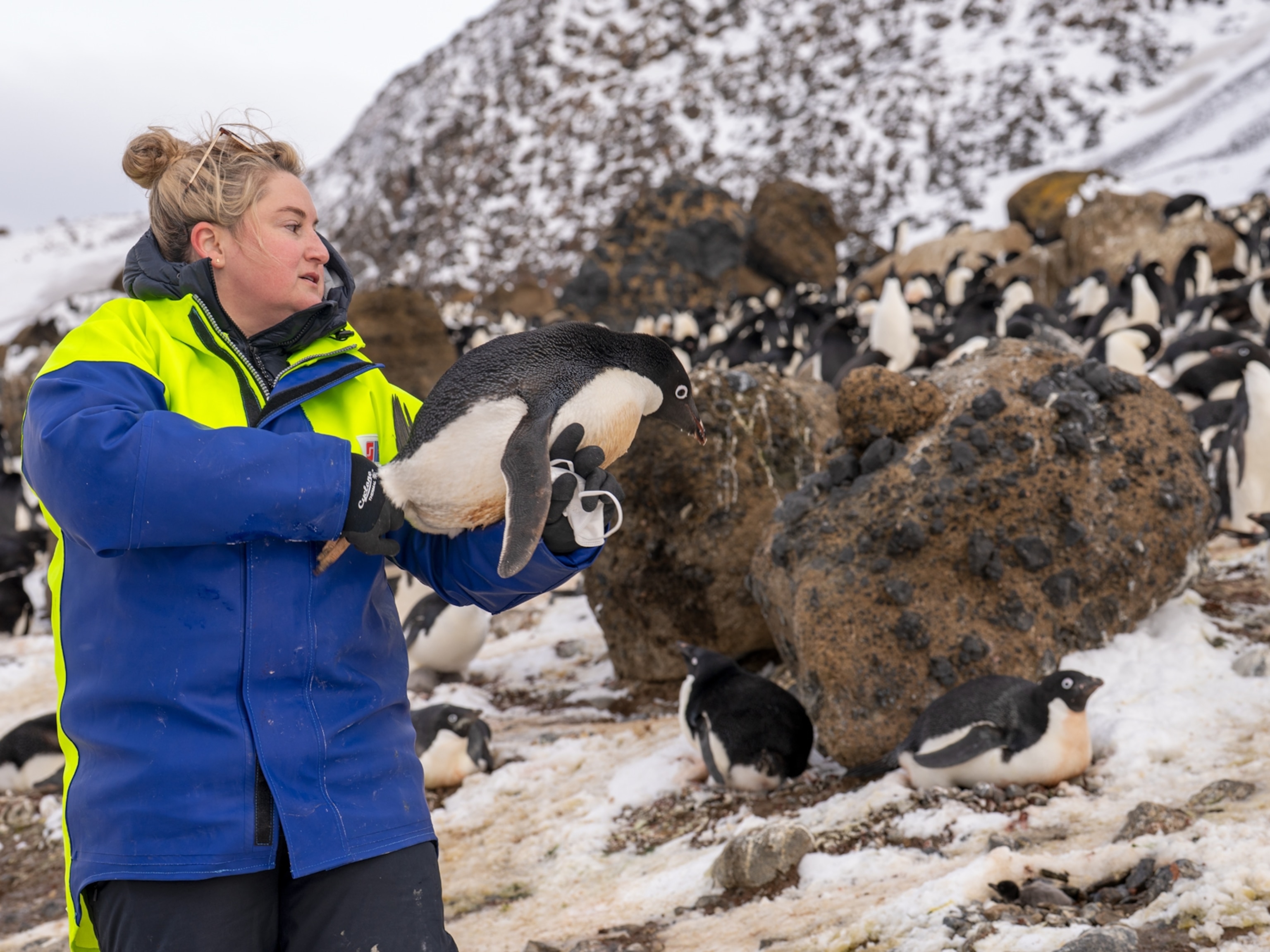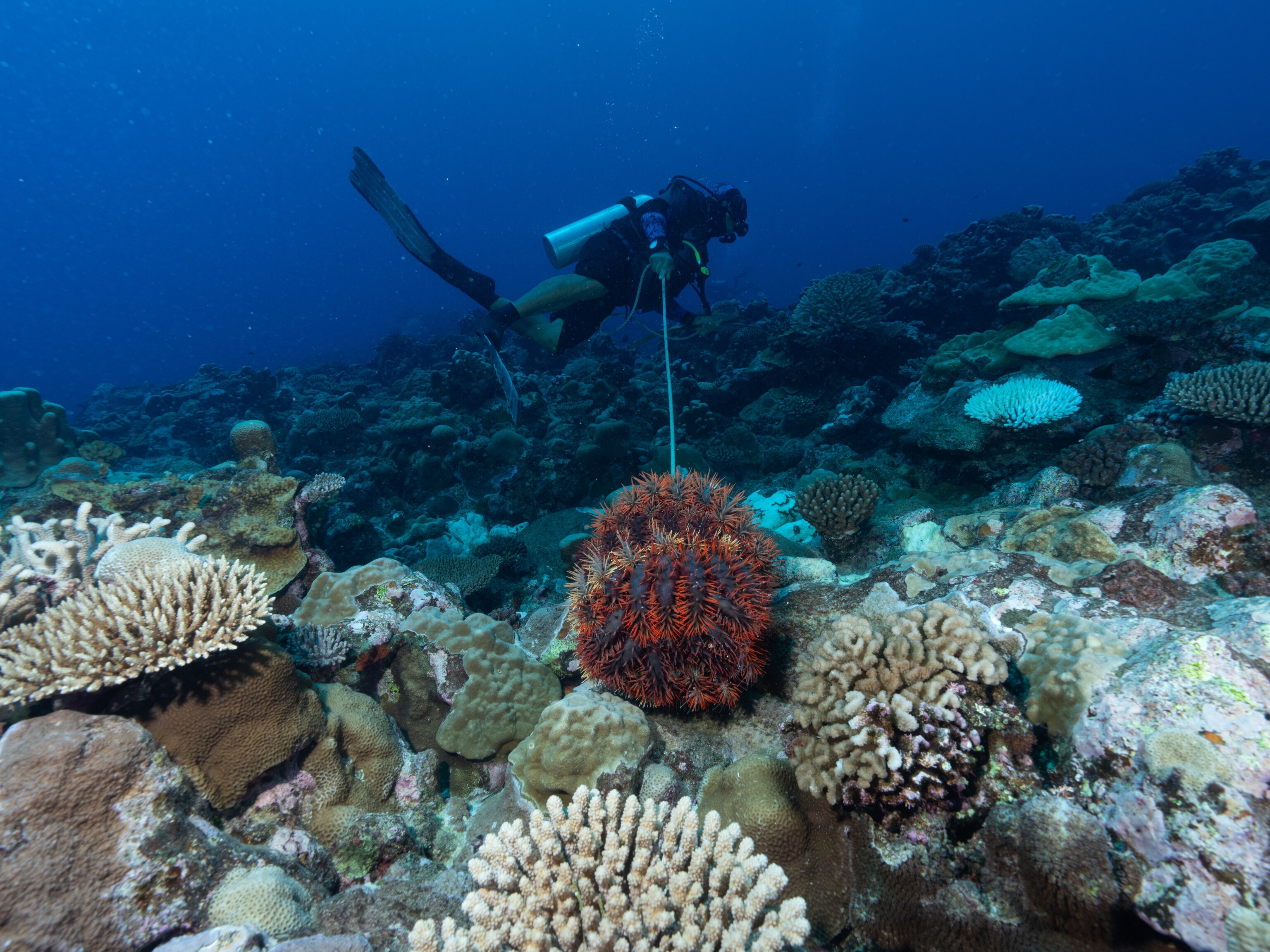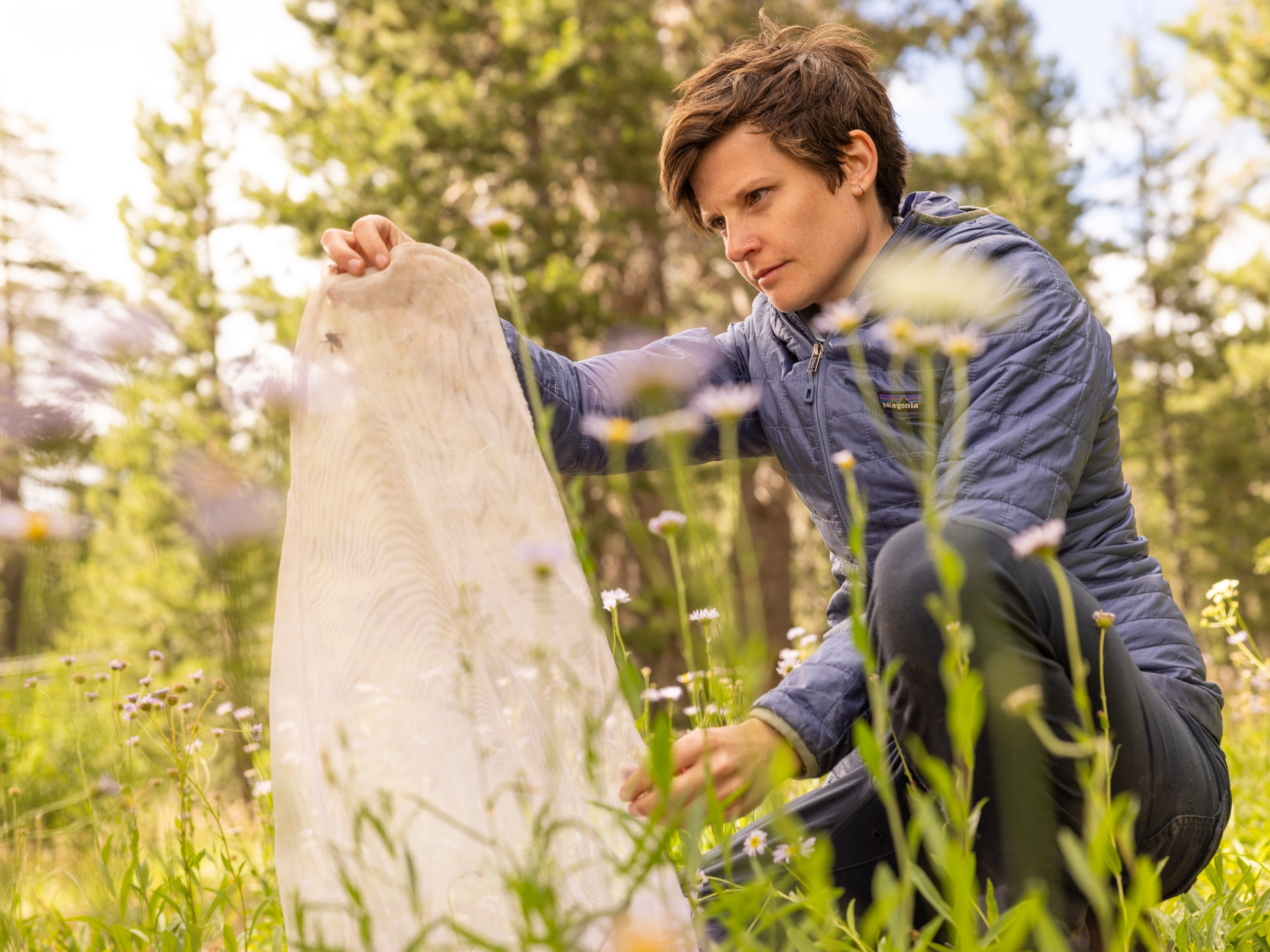
What Makes Risk Takers Tempt Fate?
Recent research suggests that genetic, environmental, and personal factors can make people take on risky—even potentially fatal—challenges.
Moments before hurling herself off a thousand-foot cliff, professional climber, wingsuiter and BASE jumper Steph Davis feels a surge of fear and excitement. Her heart rate spikes and her insides rumble. As she pushes away from edge, those electric feelings give way to an intense rush, then deep focus. She must position her body just so for her wingsuit to fill with air. Then, she must deploy her parachute at precisely the right moment and nail her landing, often within the span of 60 seconds.
She’s jumped off thousands of cliffs and understands the risks inherent to her sport. In 2013, her husband Mario Richard died while they were wingsuiting together in the Dolomites. Two years later, her ex-husband Dean Potter died in a wingsuiting accident in Yosemite Valley, California. Just this week, fellow wingsuiter and BASE jumper Cameron Minni died when he tried to jump from Ha Ling Peak outside of Canmore, Alberta. According to a study by the University of Colorado School of Medicine, 76 percent of fliers have experienced a close call.
Despite the danger, Davis tries to BASE jump or wingsuit almost every day of the year.
In the face of such devastating consequences, why are some people drawn to risky endeavors—to surfing waves 10 stories high, launching off cliffs on skis, or sailing through the air in a wingsuit? The answer may lie in a complex mix of genetic, psychological, and environmental factors.
Born With a Taste for Adventure
Even before we’re born, our appetite for risk may be mapped out in our DNA. “Certain individuals may be driven to take risks in order to reap the rewards, the rush—and this may be in part due to their genetic make up,” says Cynthia Thomson, PhD, the researcher behind a 2014 study from the University of British Columbia that suggests that risk-taking behavior is, at least in part, genetic. Thomson’s study was the first to look at the genetic factors that might make someone predisposed to participating in extreme sports, which are typically defined as activities where death or severe injury is a very real possibility. Think sky-diving, skiing potentially fatal slopes, or rock climbing without a rope.
For her research, Thomson, an avid skier and climber, headed to Whistler’s Telus World Ski and Snowboard Festival. She recruited 386 volunteers—many of whom were professional skiers and snowboarders—to study a variant of the DRD4 receptor, the so-called “adventure gene.”
After analyzing her volunteers’ DNA, Thomson’s results suggested that individuals drawn to riskier sports may have a genetic predisposition to do so. “I found that individuals who reported riskier behaviors were more commonly of a certain type of genotype,” explains Thomson. In other words, risk takers shared a similar genetic constitution.
Though scientists are still trying to understand how this genetic variant may affect one’s physiology, it’s believed that it influences how the body processes dopamine, a neurotransmitter involved in pleasure-seeking and reward-motivated behaviors. Dopamine is behind the high one feels when charging down a spicy backcountry slope or climbing a sheer rock face—or when using drugs. In fact, the neurotransmitter is linked to drug addiction.
Researchers believe that people with this genetic variant produce more dopamine receptors, which affects them in two ways. First, it could mean that someone with more receptors needs more dopamine to reach a stimulated state, “so they need to seek out intense situations to bring up their dopamine levels,” says Thomson.
Another idea is that a person with more of these receptors experiences a greater burst of dopamine during intense situations, making the rush feel that much better than that of some with an average number of receptors. This exaggerated sensation could reinforce the behavior and make that individual more likely to do it again because it feels so good.
Several studies suggest that our taste for adventure may be linked to our earliest experiences in the womb and how much testosterone we’re exposed to in utero. In addition to the levels of testosterone naturally present in the mother’s body, the fetus also produces the hormone. The fetal production of testosterone is determined by genetics—a male fetus produces more of the hormone. It’s believed that prenatal testosterone alters the brain structures that govern fear and reward processing. As the theory goes, the more testosterone you’re exposed to as a fetus, which men naturally are due to their Y chromosome, the more adventure you’ll crave.
That’s because testosterone plays a role in the masculinization of the brain during fetal development. The more prenatal testosterone in the womb, the more masculinized the brain becomes, which means the fetus will go on to exhibit more male-typical behavior after birth—such as rough-and-tumble play in early years and risk-taking behavior as an adult. An analysis of existing research in 2011 found that higher exposure to prenatal and pubertal testosterone was associated with a propensity for financial risk-taking, and might predict a person's susceptibility to gambling addiction.
A 2011 study led by Eric Stenstrom, a professor at Miami University’s Farmer School of Business, studied the effects of prenatal testosterone on recreational, financial, and social risk taking. By studying the ratio between the second and fourth fingers, a common marker for prenatal testosterone exposure, Stenstrom and his colleagues were able to determine that a lower ratio between the two digits, which is typical of men, was predictive of greater risk-taking in social and recreational domains, things like whitewater rafting and skiing.
“Greater testosterone exposure in utero leads to taking greater risks in adulthood in various realms of life, from the board room to the ski hill,” says Stenstrom. “It’s likely that extreme athletes were exposed to higher than average levels of prenatal testosterone, albeit our research hasn’t measured this directly.”
A Complex Mix of Influences
However, most scientists agree that personality is an intricate mix of environmental and genetic influences. When it comes to environmental factors, several studies have shown that risk-taking behavior is linked to the earliest bonds we form with our primary caretakers.
While no study has looked directly at the role of parental attachment as it pertains to extreme sports, several studies have examined its affect on other risky behaviors—promiscuous sex, gambling, drugs—and determined that those with less secure attachments are more likely to engage in dangerous activities.
And then there’s the common perception that extreme sports enthusiasts are chasing thrills, but Tim Woodman, a sports psychology professor at the Bangor University in Wales, suggests that it's about something altogether different: emotional regulation. In his view, people who partake in high-risk sports often have difficulty experiencing emotions, a condition called alexithymia. They seek out extreme sports as a way to actually feel.
“These activities force emotion out of them and that primary emotion is fear. So the person who has difficulty with emotions, goes into an environment to feel their emotions,” Woodman says.
If a person has difficulty experiencing and expressing emotions in everyday life, then risk-taking activities become an exercise in empowerment in which he or she is able to conquer the most primal emotion of them all: fear. “It is rewarding because they have moved from a feeling of inadequacy to a sense of achievement,” says Woodman.
A Life Wish
Some of the most interesting research into risk-taking behavior in recent years has debunked the notion that daredevils are reckless thrill seekers.
After Thomson’s 2014 study, she headed to the adventure sports capital of Chamonix, France, where she carried out a psychology study on a broader group of high-risk sports participants, which included not only skiers and snowboarders, but also ice climbers, ski mountaineers, and paragliders.
She compared the high-risk sports group to low-risk sports participants—runners and yoga enthusiasts—to determine the prevalence of the psychological trait of impulsivity, or the tendency to act with little or no forethought or consideration of consequences.
“The media portrays high-risk sports people as being reckless, as being adrenaline junkies who are out to get a high no matter what,” says Thomson. “But what I found is that my high-risk sports group, they’re not impulsive. They’re not reckless. Compared to my low risk group, I found no difference in impulsivity.”
- National Geographic Expeditions
Her findings suggest that, contrary to the commonly held stereotype, extreme athletes don’t carelessly risk their lives in pursuit of thrills. Instead, they’re highly skilled masters of their discipline who take a very thoughtful approach to their sports.
Thomson builds on the work of psychologist Eric Brymer, a researcher for Queenstown University of Technology in Brisbane, Australia, who has spent years studying extreme athletes.
"They’re actually extremely well-prepared, careful, intelligent, and thoughtful athletes with high levels of self-awareness and a deep knowledge of the environment and of the activity,” says Brymer.
For years, professional skiers, BASE jumpers, and climbers have argued that they’re not reckless, death-wish-having cowboys. Now, recent research suggests they’re right.
“What participants get from extreme sports is deeply transformational, a sense of connecting with a deep sense of self and being authentic, a powerful relationship with the natural world, a sense of freedom,” says Brymer. “They get a strong sense of living life to its fullest as if touching their full potential. Extreme sports participation is about a life wish.”
When it comes to her own appetite for risk, Steph Davis isn’t quite sure where it came from. Her parents were teachers, and they expected her to take a more traditional path in life—one defined, she says, by “academic success.”
“I’m sure it’s all those things—environmental, genetic, things that happen to you in life, because people are so different and there can never be one thing that causes things in people,” says Davis, whose brother, interestingly enough, is also a wingsuiter, BASE jumper and climber.
“For me, I think I just got put into a situation where there was something I really felt passionate about, and was completely opposed to everything I had been brought up to do. I think I was forced to make that decision in a dramatic way. As a result of doing that, it sent me down this path of jumping completely into a place you never thought of doing before and it working out,” she says.
Davis has made peace with the fact that she could die at any moment. But for her, as Brymer noted, wingsuiting isn’t about dying. It’s about squeezing the most out of every precious moment she’s got left.







